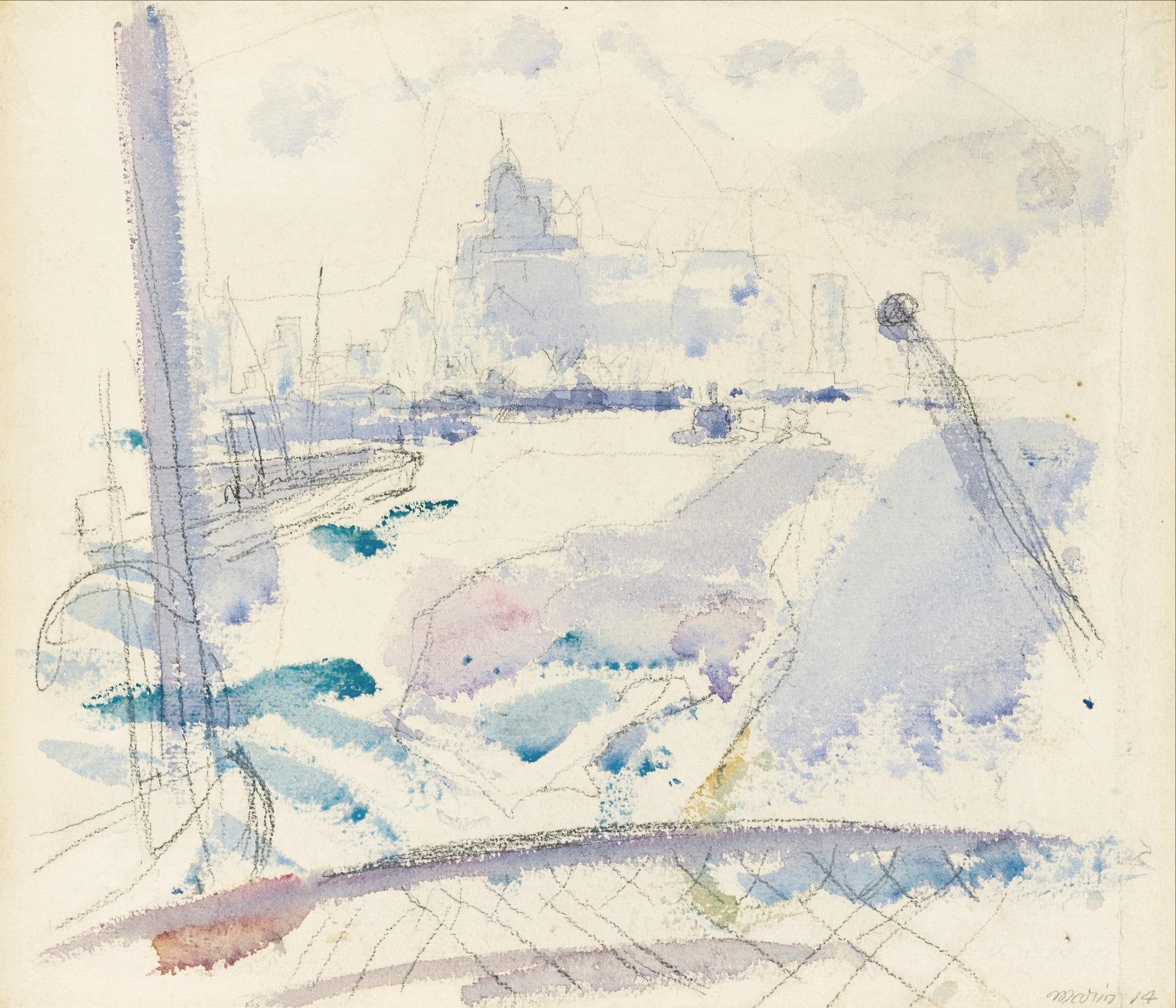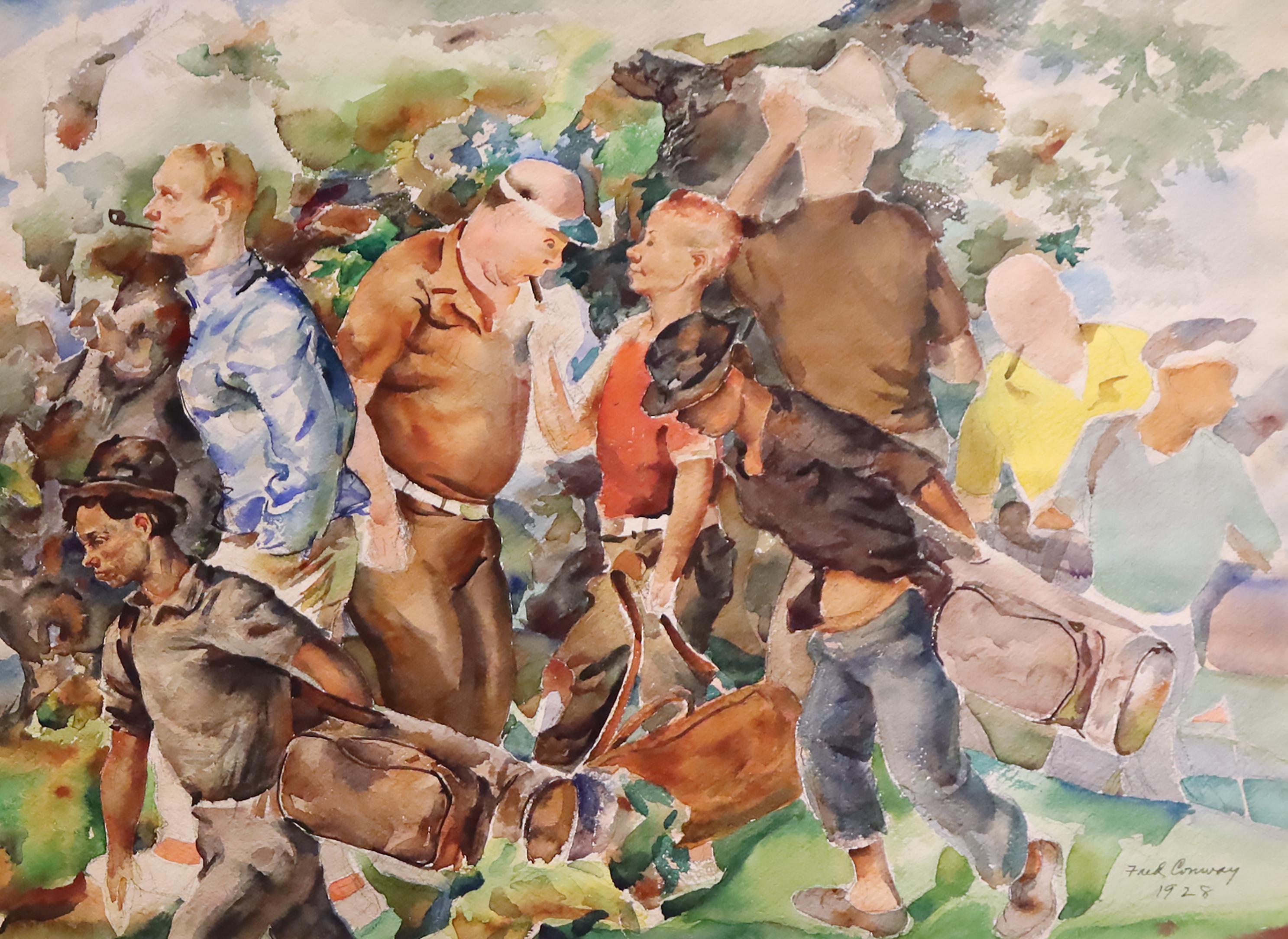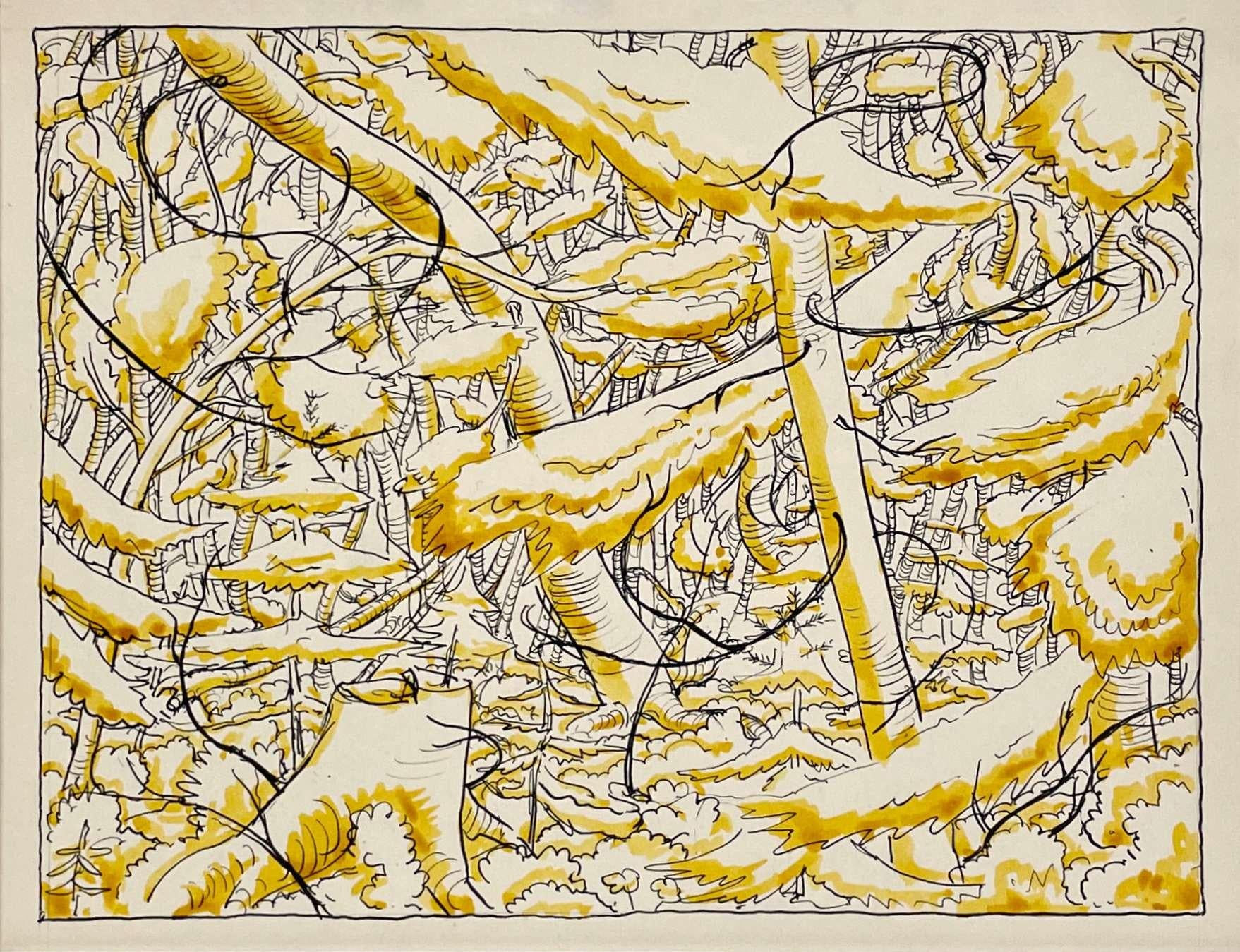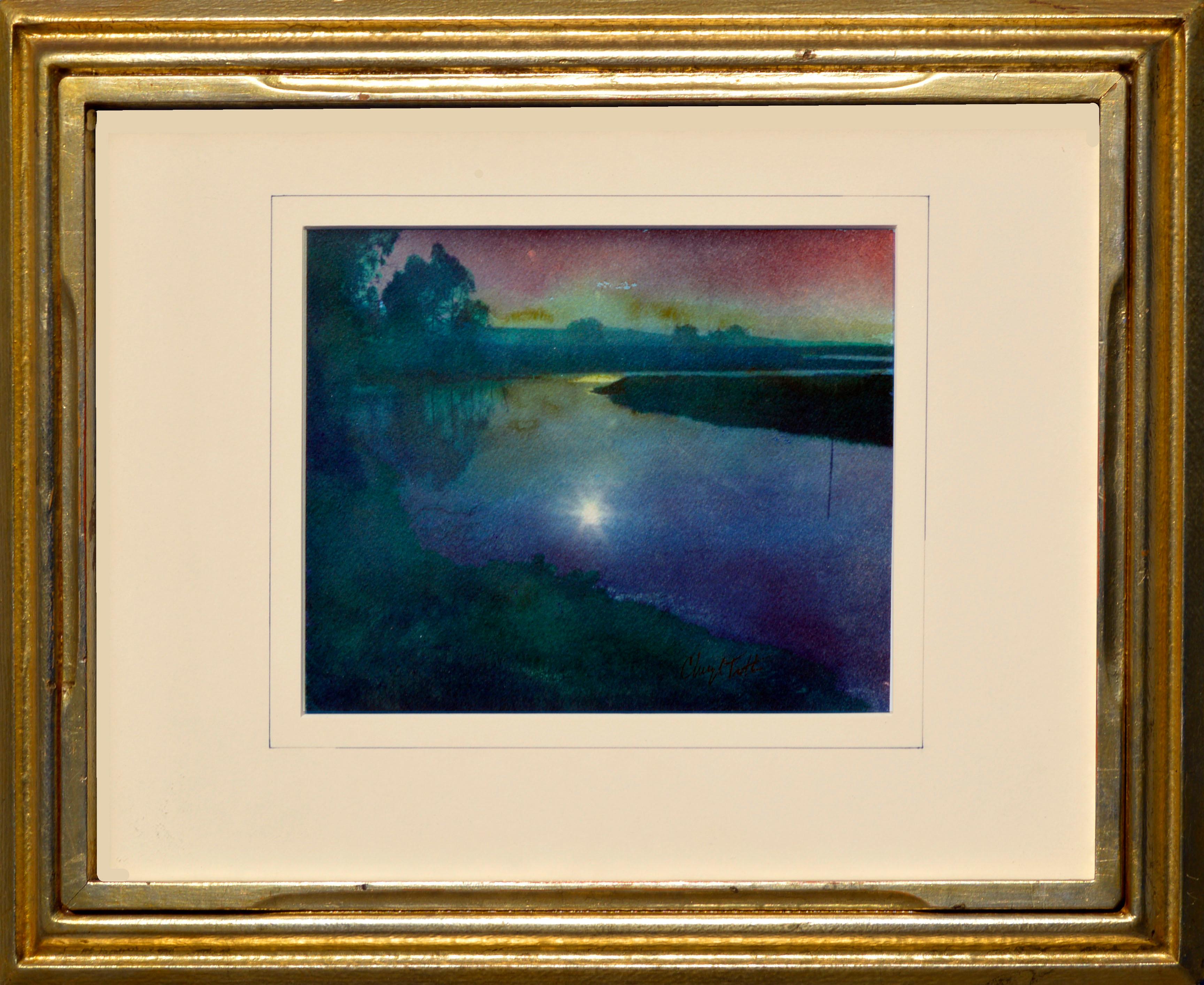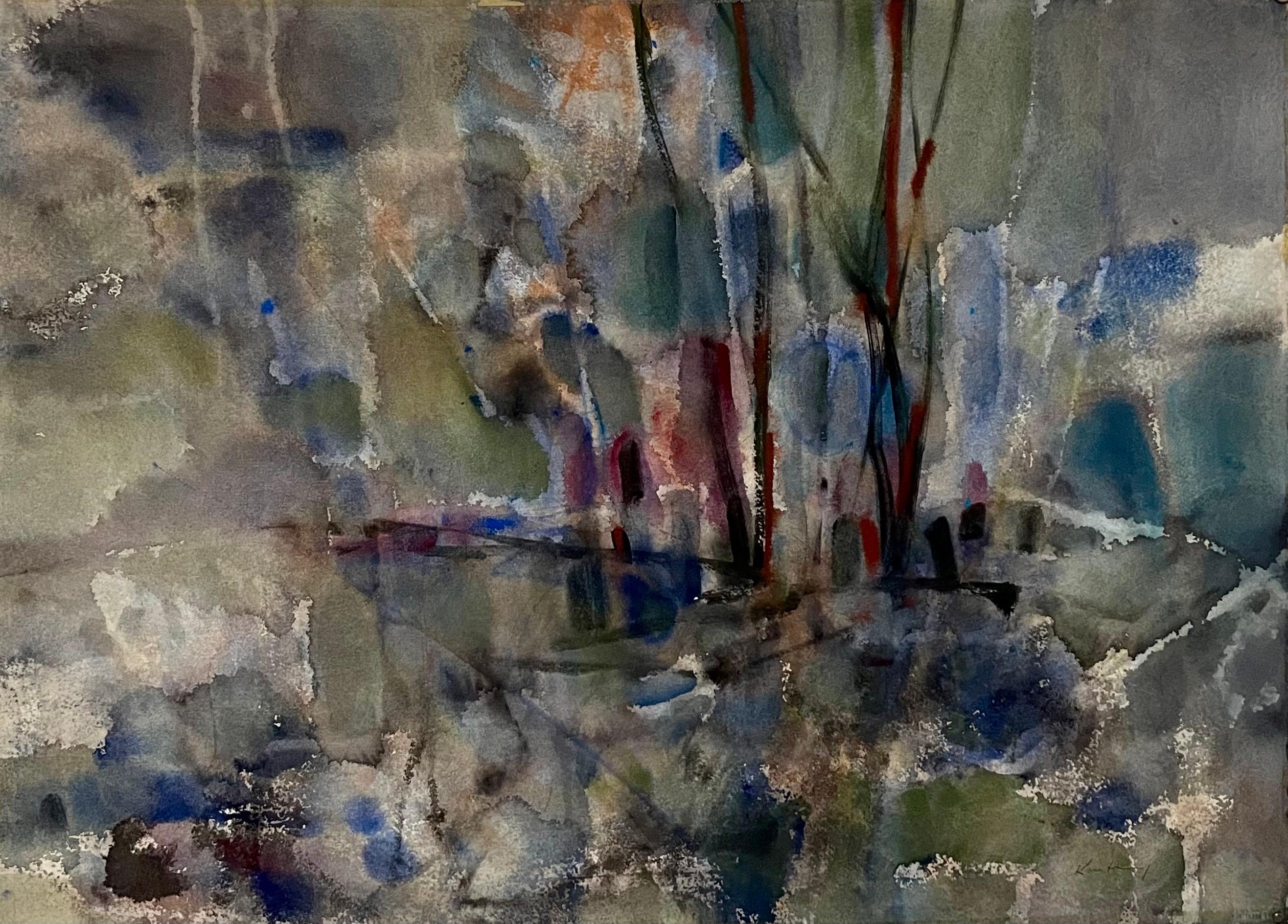Items Similar to Abstracted Forest Landscape
Want more images or videos?
Request additional images or videos from the seller
1 of 12
DershamAbstracted Forest Landscapelate 20th Century
late 20th Century
About the Item
Brightly colored abstract forest by unknown artist Dersham (20th Century). The trees in this piece are light in color, standing out from the saturated background. Multiple layers of trees create depth, showing the forest receding into the background, with a bright orange midlayer of trees creating a glowing effect, as if the sun were striking the trees in a variegated manner.
Signed in the lower right corner, on the inner mat.
Presented in a silver aluminum frame with a ribbed double mat and glass.
Paper size: 7.5"H x 11.5"W
- Creator:Dersham
- Creation Year:late 20th Century
- Dimensions:Height: 12.25 in (31.12 cm)Width: 16.25 in (41.28 cm)Depth: 0.75 in (1.91 cm)
- Medium:
- Movement & Style:
- Period:
- Condition:
- Gallery Location:Soquel, CA
- Reference Number:
About the Seller
4.9
Platinum Seller
These expertly vetted sellers are 1stDibs' most experienced sellers and are rated highest by our customers.
Established in 1986
1stDibs seller since 2014
2,545 sales on 1stDibs
Typical response time: <1 hour
- ShippingRetrieving quote...Ships From: Soquel, CA
- Return PolicyA return for this item may be initiated within 14 days of delivery.
More From This SellerView All
- "Elkhorn Slough" - Cyanotype / Watercolor LandscapeBy Cheryl TrotterLocated in Soquel, CASoft watercolor accents add to the beauty of this cyanotype and watercolor titled "Elkhorn Slough" by Cheryl Trotter (American, 20th century), c.1980's....Category
1980s American Modern Mixed Media
MaterialsWatercolor, Laid Paper, Photographic Paper
- Lou's Landing - Original Watercolor On PaperLocated in Soquel, CALou's Landing - Original Watercolor On Paper Original watercolor on paper by Ray Skelton (American 20th c.), depicting a boat harbor with numerous boats tied up, some sailing. Lou's...Category
1960s American Modern Landscape Drawings and Watercolors
MaterialsPaper, Watercolor
- Untangling a Fly from the TreeBy Harvey EckertLocated in Soquel, CADelicate depiction of a fly fisherman by Harvey Eckert (American, 1946-2018). Signed in the lower right corner. Presented in a wood frame with a double mat and anti-glare glass. Image size: 14"H x 18"W Harvey Eckert (American, 1946-2018) was an American artist from Kansas. He attended Colby Community College, Hays Emporia State and graduated from Wichita University with two degrees. While living in Montana, he was employed by Bob Wards, Fran Johnson’s Sporting Goods and Cashell Engineers as a surveyor and draftsman. Eckert illustrated three books, Caddisflies by the late Gary LaFontaine, Montana Trout Flies and The Master Fly Weaver by the late George Grant. He did illustrations for the following publications: Montana Outdoors, Colorado Streamside, The River Rat published by Trout Unlimited, Fly Fisherman, Rod and Reel...Category
1980s American Modern Figurative Drawings and Watercolors
MaterialsWatercolor, Paper
- The Fly Fisherman, Figurative Landscape WatercolorBy Harvey EckertLocated in Soquel, CADelicate depiction of a fly fisherman in the rain by Harvey Eckert (American, 1946-2018). This highly detailed landscape watercolor depicts a man fishing in the rain, wading into the water as he smokes a pipe under a tree. Signed and dated in the lower right corner. Presented in a wood frame with a double mat and anti-glare glass. A check from the original purchase is attached to verso (blurred for privacy). Image size: 14"H x 18"W Harvey Eckert (American, 1946-2018) was an American artist from Kansas. He attended Colby Community College, Hays Emporia State and graduated from Wichita University with two degrees. While living in Montana, he was employed by Bob Wards, Fran Johnson’s Sporting Goods and Cashell Engineers as a surveyor and draftsman. Eckert illustrated three books, Caddisflies by the late Gary LaFontaine, Montana Trout Flies and The Master Fly Weaver by the late George Grant. He did illustrations for the following publications: Montana Outdoors, Colorado Streamside, The River Rat published by Trout Unlimited, Fly Fisherman, Rod and Reel...Category
1980s American Modern Figurative Drawings and Watercolors
MaterialsWatercolor, Paper
- Hilltop Through the Trees, Modernist Watercolor LandscapeLocated in Soquel, CAA vibrant modernist landscape watercolor by Laguna Beach, California artist Nevalda Bartolini Liberi (Italian/American, 20th Century). This lovely and bright watercolor features a view of a beautiful hillside, seen through a grove of twisting trees. A charming house is glimpsed in the distance. Signed "Nevalda Bartolini" lower right. Displayed in a new white mat. Unframed. Paper size: 15"H x 22.25"W. Nevalda Bartolini Liberi was an Italian-American artist active in New York in the 1960's, and later in Laguna Beach, California. She was married to the prolific painter, sculptor, and former Laguna Beach gallery owner Dante Liberi...Category
Late 20th Century American Modern Landscape Drawings and Watercolors
MaterialsWatercolor, Paper
- 1940's California Hills LandscapeBy Erle LoranLocated in Soquel, CASubstantial and period mid-century modern American Scene watercolor of the Oakland, California countryside by Erle Loran (American, 1905-1999), 1944. Signed lower right "Earl Loran...Category
1940s American Modern Landscape Drawings and Watercolors
MaterialsWatercolor, Archival Paper
You May Also Like
- "New York from the Ferry" John Marin, American Modernism Watercolor, CityscapeBy John MarinLocated in New York, NYJohn Marin New York from the Ferry, 1914 Signed and dated lower right Watercolor and graphite on paper 11 x 12 3/4 inches Provenance: An American Place, New York Kennedy Galleries, Inc., New York Christie's, New York, March 16, 1990, Lot 278 Private Collection (acquired from the above) Sotheby's New York, American Paintings, Drawings, & Sculpture, October 2, 2014, Lot 10 A major figure in early twentieth-century modernism, John Marin captured the colliding energies of the American urban scene and the vibrant contrasts of natural elements in the coastal landscape of Maine and other countryside locales. As one of the premier watercolorists of his era, Marin developed a light, spontaneous style ideally suited to conveying the freshness and flux of city and country experience -- his watercolors are often considered to match in strength those created by Winslow Homer in previous century. At the same time, Marin's sensitivity to mass, form, color, and line and their dynamic interchanges provided a precedent for the Abstract Expressionist movement of the late 1950s. Marin was born in Rutherford, New Jersey, to a family of European descent. After studying mechanical drawing and mathematics for half a year at the Stevens Institute of Technology in New York, Marin worked as a draftsman for several architects. It was not until he was almost thirty years old that he began to study art. He enrolled at the Pennsylvania Academy of the Fine Arts in Philadelphia from 1899 to 1901, and at the Art Students League in New York from 1901 to 1903, where his teachers were William Merritt Chase and Frank Vincent Dumond. While Marin was attending the League, the radical ideas of Arthur Wesley Dow were being disseminated and had an impact on the direction Marin would soon take in his art. Marin left for Europe in 1905. The next five years, which he spent abroad, were of tremendous importance to his career. He became a significant figure in the expatriate community in Paris, frequenting the Dôme, a café that served as a meeting place for artists and writers. While in Europe, Marin visited the Louvre and the Rijksmuseum in Amsterdam and, despite his claims that he had been indifferent to the Paris art world, he undoubtedly became aware of the art of Paul Cézanne and Henri Matisse. The works Marin created in Europe most strongly reflect the influence of James McNeill Whistler, especially the pastels he rendered in Venice. In the summer of 1909, Marin met Alfred Stieglitz in Paris. In February of the next year, Marin's work was shown along with that of Alfred Maurer at Stieglitz's gallery, 291. After returning to America in the following year, Marin became one of the most consistent members of Stieglitz's inner circle, showing at all three of his galleries -- 291, The Intimate Gallery, and An American Place. After 1910, Marin developed the routine that he would follow for the rest of his life, creating paintings, drawings, and prints in New York City and surrounding areas during the winter, and in the summer, traveling to the country, where he focused on the particular characteristics of the regions that he visited. He worked mainly in watercolor until 1928, when he began also to use oil. Marin never became purely abstract. He formulated a unique style melding influences of the art of the French Fauves, Cézanne, Matisse, and the French Cubists with a personal style of luminescent colors, agile brushwork, and a simultaneously delicate and strong handling. In city views, he used broken lines, a light touch, fluid color, and rhythmic compositions to convey what he described as the "great forces at work." He expressed the warring of the great and the small through relationships between masses. As he said, he sought to express the "pull forces" of the modern urban scene. Often portraying the new tall buildings of New York seen...Category
1910s American Modern Landscape Drawings and Watercolors
MaterialsPaper, Watercolor
- GolfersBy Frederick ConwayLocated in Missouri, MOGolfers, 1928 Fred Conway (American, 1900-1973) Signed and Dated Lower Right 18.5 x 24.5 inches 30.5 x 37 inches with frame A member of the faculty of the Washington University Art ...Category
1920s American Modern Figurative Drawings and Watercolors
MaterialsPaper, Watercolor
- Forest Scene, Study in Yellow by artist Harold HaydonBy Harold HaydonLocated in Chicago, ILA ca. 1931 charming watercolor forest scene; a study in yellow by artist Harold Haydon. Harold Emerson Haydon was born in Fort William, Ontario, Canad...Category
1930s American Modern Landscape Drawings and Watercolors
MaterialsInk, Pen, Watercolor, Paper
- Modernist Abstract Expressionist Watercolor Painting Bauhaus Weimar Pawel KontnyBy Pawel KontnyLocated in Surfside, FLAbstract watercolor composition bearing the influence of the earlier color-block compositions of Paul Klee. Pawel August Kontny, (Polish-German-American artist) He was born in Laurahuette, Poland, in 1923, the son of a wealthy pastry shop owner. In 1939 he began studying architecture in Breslau where he was introduced to the European masters and to the work of some of the German Expressionists, soon afterward banned as "degenerate artists" and removed from museums throughout Germany by the Nazi regime. His studies were interrupted by World War II. Drafted into the German army, traveling in many countries as a soldier, he sketched various landscapes but in 1945, he was captured and held as a prisoner of war in Italy. After the war, he studied at the Union of Nuremberg Architects to help design buildings to replace ones destroyed in the war. He recorded his impressions of the local population and the landscapes through his watercolors and drawings. Pawel Kontny thereafter moved to Nuremberg, Germany, becoming a member of the Union of Nuremberg Architects and helping to rebuild the city's historic center. He soon decided to concentrate on his professional art career. He married Irmgard Laurer, a dancer with the Nuremberg Opera. Pavel Kontny 's career as an artist was launched with his participation in an all German exhibition, held at the Dusseldorf Museum in 1952. He held one-man shows in Germany, Switzerland and the United States. During his trip to the United States in 1960, Kontny became instantly enamored with Colorado, and decided to relocate to Cherry Hills with his wife and two children. He quickly established himself in the local art community, being affiliated for a time with Denver Art Galleries and Saks Galleries. His subject matter became the Southwest. During this time he received the Prestigious Gold Medal of the Art Academy of Rome. His extensive travel provided material for the paintings he did using his hallmark marble dust technique. he also worked equally in pastel, watercolor, charcoal and pencil-and-ink. in a style which merged abstraction and realist styles, influenced by Abstract Expressionist painting and South Western American landscapes. This one bears the influence of Sam Francis. In the early 1960s he was one of only a few European-born professional artists in the state, a select group that included Herbert Bayer (1900-1985), a member of the prewar Bauhaus in Weimar and Dessau, Germany, and Roland Detre (1903-2001), a Hungarian modernist painter. As a Denver, Colorado resident, Pavel Kontny exhibited at galleries and museums throughout the United States, Germany and Japan. There, he was inspired by frequent trips to Native American pueblos in the Southwest, as well as by the study of the Plains Indians of Montana and Wyoming. Over the years Kontny had a number of students and generously helped young artist by hosting exhibitions at his Cherry Hills home. For many years he generously donated his paintings to support charitable causes in Denver. Influences during his European years included German pastelist C.O. Muller, German Informel painter Karl Dahmen and Swiss artist, Hans Erni. In the early 1950s his painting style showed the influence of the Die Brücke (The Bridge), a group of German expressionist artists formed in Dresden in 1905 who had a major impact on the evolution of modern art in the twentieth century in Germany. By the middle of the decade his style incorporated more referential abstraction and total abstraction, resulting in part from his study of Hans Hartung, a German artist based in Paris who exhibited his gestural abstract work in Germany. The American moon landing in 1969 inspired Paul Kontny...Category
20th Century American Modern Abstract Drawings and Watercolors
MaterialsWatercolor, Archival Paper
- Modernist Abstract Expressionist Watercolor Painting Bauhaus Weimar Pawel KontnyBy Pawel KontnyLocated in Surfside, FLAbstract watercolor composition bearing the influence of the earlier color-block compositions of Paul Klee. Pawel August Kontny, (Polish-German-American artist) He was born in Laurahuette, Poland, in 1923, the son of a wealthy pastry shop owner. In 1939 he began studying architecture in Breslau where he was introduced to the European masters and to the work of some of the German Expressionists, soon afterward banned as "degenerate artists" and removed from museums throughout Germany by the Nazi regime. His studies were interrupted by World War II. Drafted into the German army, traveling in many countries as a soldier, he sketched various landscapes but in 1945, he was captured and held as a prisoner of war in Italy. After the war, he studied at the Union of Nuremberg Architects to help design buildings to replace ones destroyed in the war. He recorded his impressions of the local population and the landscapes through his watercolors and drawings. Pawel Kontny thereafter moved to Nuremberg, Germany, becoming a member of the Union of Nuremberg Architects and helping to rebuild the city's historic center. He soon decided to concentrate on his professional art career. He married Irmgard Laurer, a dancer with the Nuremberg Opera. Pavel Kontny 's career as an artist was launched with his participation in an all German exhibition, held at the Dusseldorf Museum in 1952. He held one-man shows in Germany, Switzerland and the United States. During his trip to the United States in 1960, Kontny became instantly enamored with Colorado, and decided to relocate to Cherry Hills with his wife and two children. He quickly established himself in the local art community, being affiliated for a time with Denver Art Galleries and Saks Galleries. His subject matter became the Southwest. During this time he received the Prestigious Gold Medal of the Art Academy of Rome. His extensive travel provided material for the paintings he did using his hallmark marble dust technique. he also worked equally in pastel, watercolor, charcoal and pencil-and-ink. in a style which merged abstraction and realist styles, influenced by Abstract Expressionist painting and South Western American landscapes. This one bears the influence of Sam Francis. In the early 1960s he was one of only a few European-born professional artists in the state, a select group that included Herbert Bayer (1900-1985), a member of the prewar Bauhaus in Weimar and Dessau, Germany, and Roland Detre (1903-2001), a Hungarian modernist painter. As a Denver, Colorado resident, Pavel Kontny exhibited at galleries and museums throughout the United States, Germany and Japan. There, he was inspired by frequent trips to Native American pueblos in the Southwest, as well as by the study of the Plains Indians of Montana and Wyoming. Over the years Kontny had a number of students and generously helped young artist by hosting exhibitions at his Cherry Hills home. For many years he generously donated his paintings to support charitable causes in Denver. Influences during his European years included German pastelist C.O. Muller, German Informel painter Karl Dahmen and Swiss artist, Hans Erni. In the early 1950s his painting style showed the influence of the Die Brücke (The Bridge), a group of German expressionist artists formed in Dresden in 1905 who had a major impact on the evolution of modern art in the twentieth century in Germany. By the middle of the decade his style incorporated more referential abstraction and total abstraction, resulting in part from his study of Hans Hartung, a German artist based in Paris who exhibited his gestural abstract work in Germany. The American moon landing in 1969 inspired Paul Kontny...Category
20th Century American Modern Abstract Drawings and Watercolors
MaterialsWatercolor, Archival Paper
- Modernist Abstract Expressionist Watercolor Painting Bauhaus Weimar Pawel KontnyBy Pawel KontnyLocated in Surfside, FLAbstract watercolor composition bearing the influence of the earlier color-block compositions of Paul Klee. Pawel August Kontny, (Polish-German-American artist) He was born in Laurahuette, Poland, in 1923, the son of a wealthy pastry shop owner. In 1939 he began studying architecture in Breslau where he was introduced to the European masters and to the work of some of the German Expressionists, soon afterward banned as "degenerate artists" and removed from museums throughout Germany by the Nazi regime. His studies were interrupted by World War II. Drafted into the German army, traveling in many countries as a soldier, he sketched various landscapes but in 1945, he was captured and held as a prisoner of war in Italy. After the war, he studied at the Union of Nuremberg Architects to help design buildings to replace ones destroyed in the war. He recorded his impressions of the local population and the landscapes through his watercolors and drawings. Pawel Kontny thereafter moved to Nuremberg, Germany, becoming a member of the Union of Nuremberg Architects and helping to rebuild the city's historic center. He soon decided to concentrate on his professional art career. He married Irmgard Laurer, a dancer with the Nuremberg Opera. Pavel Kontny 's career as an artist was launched with his participation in an all German exhibition, held at the Dusseldorf Museum in 1952. He held one-man shows in Germany, Switzerland and the United States. During his trip to the United States in 1960, Kontny became instantly enamored with Colorado, and decided to relocate to Cherry Hills with his wife and two children. He quickly established himself in the local art community, being affiliated for a time with Denver Art Galleries and Saks Galleries. His subject matter became the Southwest. During this time he received the Prestigious Gold Medal of the Art Academy of Rome. His extensive travel provided material for the paintings he did using his hallmark marble dust technique. he also worked equally in pastel, watercolor, charcoal and pencil-and-ink. in a style which merged abstraction and realist styles, influenced by Abstract Expressionist painting and South Western American landscapes. This one bears the influence of Sam Francis. In the early 1960s he was one of only a few European-born professional artists in the state, a select group that included Herbert Bayer (1900-1985), a member of the prewar Bauhaus in Weimar and Dessau, Germany, and Roland Detre (1903-2001), a Hungarian modernist painter. As a Denver, Colorado resident, Pavel Kontny exhibited at galleries and museums throughout the United States, Germany and Japan. There, he was inspired by frequent trips to Native American pueblos in the Southwest, as well as by the study of the Plains Indians of Montana and Wyoming. Over the years Kontny had a number of students and generously helped young artist by hosting exhibitions at his Cherry Hills home. For many years he generously donated his paintings to support charitable causes in Denver. Influences during his European years included German pastelist C.O. Muller, German Informel painter Karl Dahmen and Swiss artist, Hans Erni. In the early 1950s his painting style showed the influence of the Die Brücke (The Bridge), a group of German expressionist artists formed in Dresden in 1905 who had a major impact on the evolution of modern art in the twentieth century in Germany. By the middle of the decade his style incorporated more referential abstraction and total abstraction, resulting in part from his study of Hans Hartung, a German artist based in Paris who exhibited his gestural abstract work in Germany. The American moon landing in 1969 inspired Paul Kontny...Category
20th Century American Modern Abstract Drawings and Watercolors
MaterialsWatercolor, Archival Paper
Recently Viewed
View AllMore Ways To Browse
Forest Landscape
Forest In Light
Vintage Forest Art
Abstract Forest Landscapes
Vintage Forest Sign
Orange Forest
Tree Painting Forest Modern
Vintage Glowing Glass
Vintage Aluminum Tree
New Look
Art Work By Black Artist
No Painting
Black Artist Painting
Vintage Art Photography
Vintage Black And White
All Abstracts
Painting Series
Important Art
